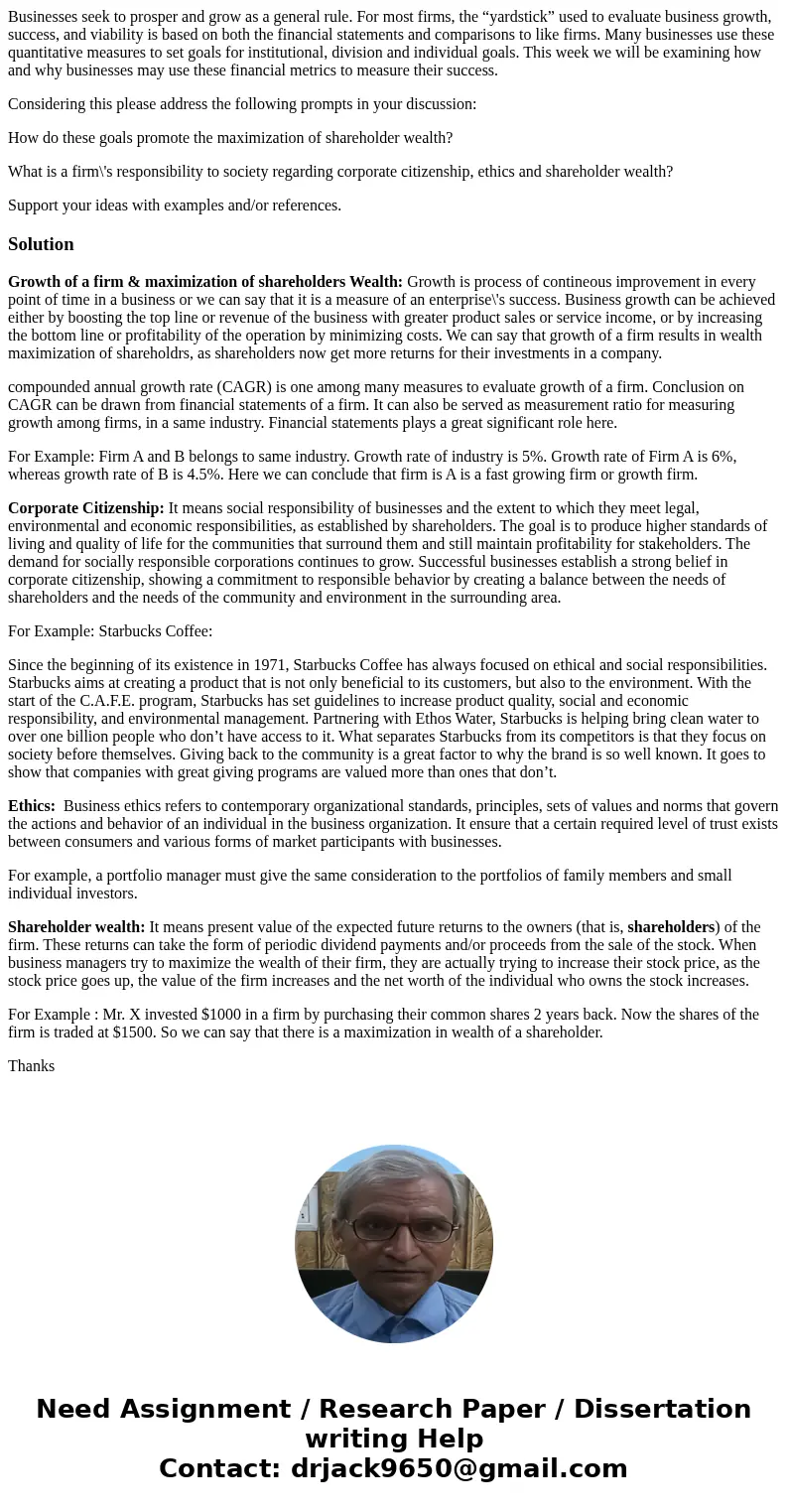Businesses seek to prosper and grow as a general rule For mo
Businesses seek to prosper and grow as a general rule. For most firms, the “yardstick” used to evaluate business growth, success, and viability is based on both the financial statements and comparisons to like firms. Many businesses use these quantitative measures to set goals for institutional, division and individual goals. This week we will be examining how and why businesses may use these financial metrics to measure their success.
Considering this please address the following prompts in your discussion:
How do these goals promote the maximization of shareholder wealth?
What is a firm\'s responsibility to society regarding corporate citizenship, ethics and shareholder wealth?
Support your ideas with examples and/or references.
Solution
Growth of a firm & maximization of shareholders Wealth: Growth is process of contineous improvement in every point of time in a business or we can say that it is a measure of an enterprise\'s success. Business growth can be achieved either by boosting the top line or revenue of the business with greater product sales or service income, or by increasing the bottom line or profitability of the operation by minimizing costs. We can say that growth of a firm results in wealth maximization of shareholdrs, as shareholders now get more returns for their investments in a company.
compounded annual growth rate (CAGR) is one among many measures to evaluate growth of a firm. Conclusion on CAGR can be drawn from financial statements of a firm. It can also be served as measurement ratio for measuring growth among firms, in a same industry. Financial statements plays a great significant role here.
For Example: Firm A and B belongs to same industry. Growth rate of industry is 5%. Growth rate of Firm A is 6%, whereas growth rate of B is 4.5%. Here we can conclude that firm is A is a fast growing firm or growth firm.
Corporate Citizenship: It means social responsibility of businesses and the extent to which they meet legal, environmental and economic responsibilities, as established by shareholders. The goal is to produce higher standards of living and quality of life for the communities that surround them and still maintain profitability for stakeholders. The demand for socially responsible corporations continues to grow. Successful businesses establish a strong belief in corporate citizenship, showing a commitment to responsible behavior by creating a balance between the needs of shareholders and the needs of the community and environment in the surrounding area.
For Example: Starbucks Coffee:
Since the beginning of its existence in 1971, Starbucks Coffee has always focused on ethical and social responsibilities. Starbucks aims at creating a product that is not only beneficial to its customers, but also to the environment. With the start of the C.A.F.E. program, Starbucks has set guidelines to increase product quality, social and economic responsibility, and environmental management. Partnering with Ethos Water, Starbucks is helping bring clean water to over one billion people who don’t have access to it. What separates Starbucks from its competitors is that they focus on society before themselves. Giving back to the community is a great factor to why the brand is so well known. It goes to show that companies with great giving programs are valued more than ones that don’t.
Ethics: Business ethics refers to contemporary organizational standards, principles, sets of values and norms that govern the actions and behavior of an individual in the business organization. It ensure that a certain required level of trust exists between consumers and various forms of market participants with businesses.
For example, a portfolio manager must give the same consideration to the portfolios of family members and small individual investors.
Shareholder wealth: It means present value of the expected future returns to the owners (that is, shareholders) of the firm. These returns can take the form of periodic dividend payments and/or proceeds from the sale of the stock. When business managers try to maximize the wealth of their firm, they are actually trying to increase their stock price, as the stock price goes up, the value of the firm increases and the net worth of the individual who owns the stock increases.
For Example : Mr. X invested $1000 in a firm by purchasing their common shares 2 years back. Now the shares of the firm is traded at $1500. So we can say that there is a maximization in wealth of a shareholder.
Thanks

 Homework Sourse
Homework Sourse